Discussion
It's fascinating to speculate as to what happened during the Early Palaeocene. Otodus was a large and long-established genus bearing smooth cutting-edged teeth and sharing the warm seas with Palaeocarcharodon, a serrated-tooth species. The convergence of tooth-designs between these sharks suggests a similar food resource and/or feeding strategy. However, the apparent appearance of an Otodus with serrated teeth 5my after the disappearance of Palaeocarcharodon, points more to an adaptation to an abandoned niche, rather than an intergeneric competition ultimately won by Otodus/ Carcharocles. Throw the evolution of cetaceans into the mix, either as living (predatory) or dead (scavenged) prey, and the possibilities are endless. In any event, the disappearance of Palaeocarcharodon from the fossil record well before the appearance of Carcharocles-type teeth and the gradual appearance of serrate Otodus teeth, which gradually 'morph' into the C. auriculatus-design, strongly suggests that the Carcharocles lineage originates with Otodus.
The shores of the Potomac provide a unique window into these Palaeogene seas. The Palaeocene sediments of the lower Aquia Formation yield both Palaeocarcharodon and Otodus teeth. These sediments are overlain by the non-fossiliferous Marlboro Clay. The Ypresian is reflected by the Nanjemoy Formation and from its lowest sediments (Potapaco Beds A & B), only teeth from Otodus have been found.
For several hundred meters on the eastern shore of the Potomac, Woodstock Bed A dips toward the Atlantic. These Middle Ypresian sediments, as the below images illustrate, document the evolution of serrate Otodus teeth. The underlying Potapaco Bed B sediments only yield unserrated teeth and the overlying Woodstock Bed B, only serrated examples.
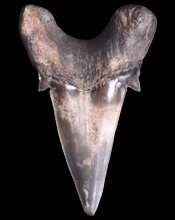 |
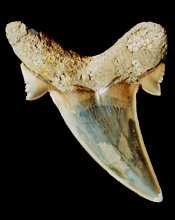 |
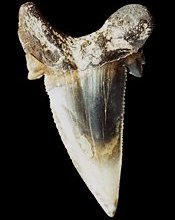 |
Nanjemoy Formation, Potapaco Bed B & Woodstock Bed A Virginia & Maryland From the collections of Mike Folmer & Gary Grimsley | ||
With evidence that approaches irrefutable, these teeth document the evolution of serrations on the cutting-edge of Otodus teeth. This evolution was gradual and apparently not universal within the genus. The below examples were all recovered in situ from the middle of Woodstock Bed A. The three tooth designs depicted in these images can represent three species (and two genera), all with different teeth, or one species with odontological variations. The authors ascribe to the later -- a single species, in this case represented by the morphospecies O. obliquus and O/C. aksuaticus.
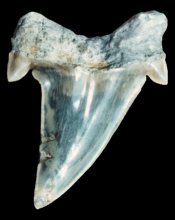 |
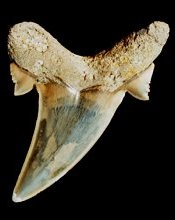 |
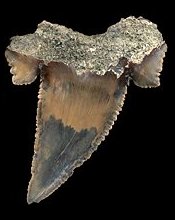 |
Nanjemoy Formation, Mid-Woodstock Bed A - Charles County, Maryland From the collections of Gary Grimsley & Jim Bourdon | ||
Although the evolution of these teeth from the O. obliquus to C. auriculatus- design is very clear, the manner of change is less certain. In Kazakhstan, the evolution is reflected as chronologically universal — Level 1 yielding Otodus obliquus, 4 only O. mugodzharicus and Level 5 C. aksuaticus. In contrast Woodstock Bed A yields teeth with the O. obliquus, slightly serrate O. obliquus and C. aksuaticus tooth-designs. There is evidence of burrowing in the Woodstock, which may account for the heterogeneous nature of the recovered teeth. However, an ontogenetic basis may also be reflected between these two sites. The Tethyian sediments produce smaller teeth (50-60% the size) from a deeper water environment as compared with their Potomac counterparts. It is possible that serrate teeth evolved, or were more important for juvenile sharks, in the Tethys Seaway and proved of less value to larger sharks or those in other areas.
The fossil record provides strong evidence for the development of serrations on the cutting-edge of Otodus teeth during the Middle Ypresian. The unanswered question, is this a new/different species? At any given point in time, it would appear that only a single biologically viable megatoothed-shark species existed. The very gradual evolution of this lineage, from Otodus obliquus to its apex as reflected by Carcharocles megalodon in the Pliocene, reflects no appreciable breaks — an excellent example of a lineage which can be divided into arbitrary morphospecies or chronospecies.
The Linnean System is a biological language designed to convey relationships, and as is the case with its spoken counterpart, language - it's not logic, it's convention. The development of serrations has been deemed significant enough to ascribe Otodus teeth to a new genus (Carcharocles) and the minor variations, to unique species. Some Russian authors view the whole lineage as Otodus (Glyckman, 1980; Zhelezko & Kozlov, 1999), a position that is very difficult to challenge. Within this paper, the authors have set aside personal opinion and attempted to follow convention whenever reasonable.
Appendix 1
See: Opening a Bag of Worms — O. subserratusAppendix 2
Zhelezko & Kozlov, 1999 is not readily available and Russian not conducive to cyber-translation software. Those authors' descriptions of Otodus aksuaticus were translated and are presented below. Several terms eluded translation and are included as transliterated text contained within double quotes. "Sosok" translates into English as 'nipple or teat'. This may equate to 'labial protuberance', but that has not yet been confirmed. "Grebni" translates into 'rowing', 'screw propeller', or the 'breaking crest of a wave'. This term is applied to the root, and may refer the shape of the lobe tips. "Mostik" has been translated as 'bridge' and refers to the portion of the crown that interconnects the cusp and lateral cusplets. Otherwise, the user should find most terms recognizable. If the reader is comfortable with Russian, the transliterated text is available.
Translation: From Zhelezko & Kozlov, 1999
Erlikh & Bourdon, 2000
Erlikh & Bourdon, 2000
Otodus aksuaticus (MENNER, 1928)
Distribution. Middle Ypresian, North-Eastern Caspian Basin
Diagnosis. Teeth large. Root and crown moderately thick. Central "sosok" weakly developed. Nutrient groove absent. Central nutrient foramen small and round. Root lobes wide and short. Teeth characterized by the presence of initial serrations on the crown's cutting edge. Cusplets small, of different size and shape. More than half of the teeth with unserrated crowns. Lateral cusplets attached by wide short bridge.
Description. Anterior teeth are of a tearing-shearing design. Roots moderately thick. Lobes wide and short. Central "sosok" weakly developed. "Grebni" absent. Instead, on the inward side of the upper part of the root, the lobes are either smooth & flat or have a broad & long depression. Crown is stout, labial & lingual sides convex, and the general shape is that of an isosceles triangle. There is a single pair of lateral cusplets which are convex on both sides. Cusplets attached by a broad short bridge, tightly adjoining the main cusp. The crown's cutting edge, of many of the available teeth, is serrate. As a rule, the cutting edge [?referring to serrations] is incomplete. Asymmetry negligible.
Lateral & posterior teeth are of a cutting design. Roots moderately developed, lobes wide and short. Central "sosok" hardly visible, "grebni" smooth or absent. Central nutrient foramen very small and round. Crowns are broad at the base and the general form is approximately that of an isosceles triangle. Cross-section oval. Lateral cusplets attached to crown - bridge is short and wide. Cutting-edge [?referring to serrations] usually incomplete. Of the many crowns observed, the initial nature is course, small serrations on the cutting-edge of the main cusp and lateral cusplets. In more than half of the collected teeth which are complete, the crowns are not serrated.
Comparison. From Otodus obliquus, distinguished by a much broader crown base and the appearance of primary "true" serrations of the crown's cutting-edge. From O. auriculatus, differentiated by irregular, roughly serrate, primary serrations of the crown.
Note. The anterior tooth of Otodus, described by L. Agassiz as Carcharodon toliapicus AGASSIZ Plate 30a, fig. 14, is closer to Otodus auriculatus disauris by general design and serration pattern.
References
Agassiz, L. J. R. 1833-1844. Recherches sur les poissons fossiles. Text (5 vols; I., xlix+188 pp., II xii+310+366 pp., III viii+390 pp., IV xvi+296 pp., V xii+122+160 pp.) and Atlas (5 vols; I 10 pl., II., 149 pl., III 83 pl., IV, 61 pl., V, 91 pl.). Neuchâtel.
Glyckman, L.S. 1980. Evolution of Cretaceous and Caenozoic Lamnoid Sharks. 3-247, pls.1-33. In Russian
Menner, V. V. 1928. The Palaeogene sharks of Mangyschlak, Emba and from the east of Oural. Bulletin de la Société des Naturalistes de Moscou Section, Géologique vol. 6(3-4): 291-338. Moscow In Russian.
Priem, F. 1912. Sur les Poissons fossiles des Terrains tertiaires superieurs du Sud de la
France. Bulletin de la Société Géologique de France, Ser.4, 12: 213-245, pls.6-7, figs.1-23. Paris.
Ward, D. J. and Wiest, R.L., 1990. A checklist of Palaeocene and Eocene sharks
and rays (Chondrichthyes) from the Pamunkey Group, Maryland and Virginia, USA.
Tertiary Research, 12(2) p 81-88.
Weems, R. E. and Grimsley, G. J., 1999. Introduction, geology, and paleogeographic setting. In:
Early Eocene Vertebrates and Plants from the Fisher/Sullivan Site (Nanjemoy Formation) Stafford County,
Virginia. Virginia Division of Mineral Resources, Pub 152. 159pp.
Woodward, A. S. 1889. Catalogue of the Fossil Fishes in the British Museum
(Natural History) Part I, London:474p. 17pl
Zhelezko , V. I. & Kozlov, V. A. 1999. Elasmobranchii and Palaeogene
biostratigraphy of Transurals and Central Asia. Materials on stratigraphy and
Palaeontology of the Urals Vol. 3. Russian Academy of Sciences Urals Branch
Uralian Regional Interdepartment Stratigraphical Comissian, Ekkaterinburg. 324pp, 61pls